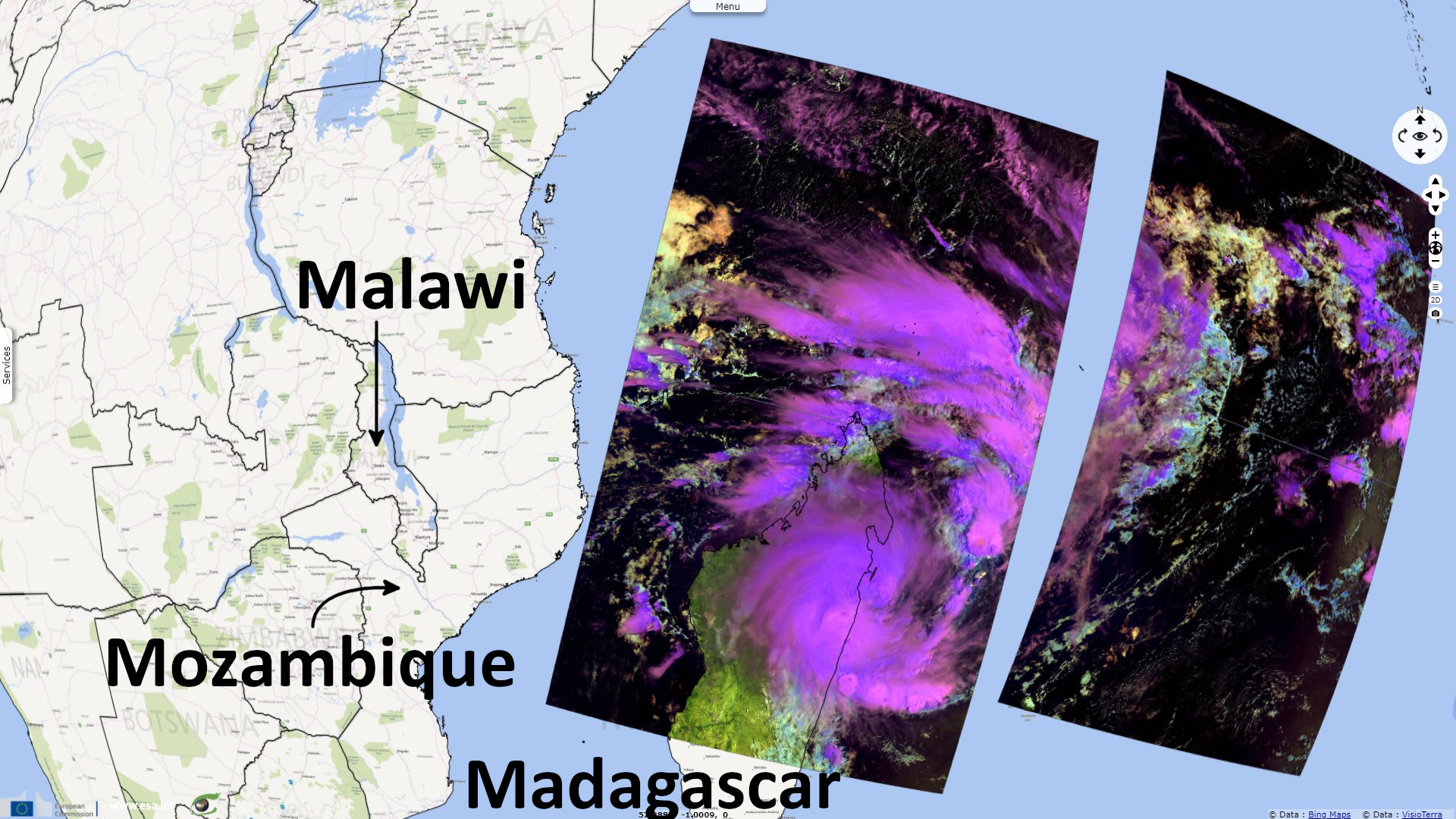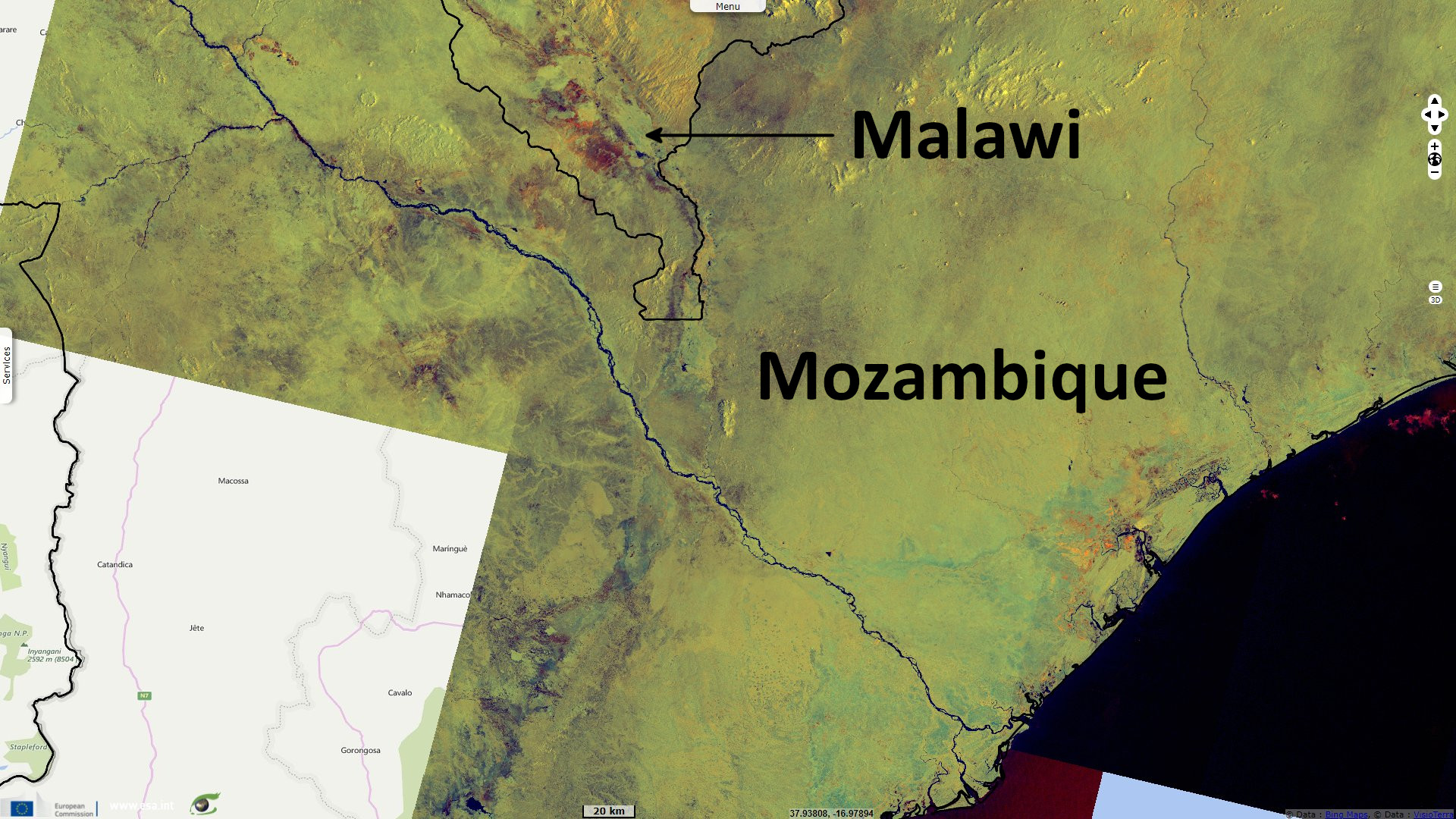Tropical Storm Ana makes +100 victims in S-E Africa
Sentinel-1 CSAR IW acquired on 14 January 2022 from 03:16:09 to 03:16:34 UTC
...
Sentinel-3 SLSTR RBT acquired on 20 January 2022 from 05:38:10 to 07:19:09 UTC and from 18:10:04 to 20:33:33 UTC
Sentinel-1 CSAR IW acquired on 26 January 2022 from 03:16:09 to 03:16:34 UTC
Sentinel-3 SLSTR RBT acquired on 26 January 2022 from 07:02:32 to 08:07:01 UTC
...
Sentinel-3 SLSTR RBT acquired on 20 January 2022 from 05:38:10 to 07:19:09 UTC and from 18:10:04 to 20:33:33 UTC
Sentinel-1 CSAR IW acquired on 26 January 2022 from 03:16:09 to 03:16:34 UTC
Sentinel-3 SLSTR RBT acquired on 26 January 2022 from 07:02:32 to 08:07:01 UTC
Keyword(s): Emergency, natural disaster, cyclone, precipitation, rain, flooding, weather, Madagascar, Mozambique, Malawi
Moderate Tropical Storm Ana was a deadly tropical cyclone that affected Madagascar and Mozambique. It was the the first named storm of the 2021–22 South-West Indian Ocean cyclone season. Despite its modest wind speed of the 95 km/h 1-minute sustained, it caused the death of at least 115 persons among four countries.
ACAPS, independent specialists in humanitarian needs analysis and assessment, detailed the impact of Ana in each country. Ana made its first landfall on Madagascar, they explain: "Tropical cyclone Ana, which formed in the Indian Ocean, made landfall in northern Madagascar on 22 January, increasing flooding and landslides that had already been affecting the country since 17 January. The most affected region is Analamanga – particularly Antananarivo, the capital city."
"Close to 60 houses are completely destroyed, and 6800 have been flooded. Many other structures are at risk of collapsing or flooding. Heavy rainfall is expected to continue, hampering recovery efforts and delaying the delivery of humanitarian aid. Shortages of fuel and other basic items are likely in the coming weeks."
ReliefWeb, a humanitarian information service provided by the United Nations Office for the Coordination of Humanitarian Affairs (OCHA), updated the toll: "In Madagascar, Tropical Storm Ana killed at least 58 people and affected at least 131 000, including 71 000 people who were displaced."
Ana then crossed the Mozambique Canal and made landfall in Mozambique, ACAPS analyzed the situation: "Tropical Storm Ana made landfall in Mozambique on 24 January, with sustained wind speed ranging from 100–130 km/h. Nampula, Tete, and Zambezia provinces were the worst hit, while Cabo Delgado, Niassa, and Sofala provinces were affected to a lesser extent. As at 1 February, the storm affected 141 483 people, killed 25, and injured 220."
"The storm also destroyed at least 7700 houses and 2457 classrooms. It damaged 30 health centres, 23 water supply systems, 144 power poles, and around 2275 km of roads. Besides representing high reconstruction costs, damages and destruction hampered access to services for the population in the affected areas. 70 982 hectares of land were flooded, including 37 930 hectares of cropland."
Malawi was also affected by Ana, the report details: "Tropical Cyclone Ana, which formed in the Indian Ocean on 21 January, made landfall in Malawi on 24 January, bringing heavy rain and causing floods. The storm affected around 20 districts in the Southern and Central regions of Malawi. The most affected districts are Phalombe, Chiradzulu, Mulanje, and Chikwawa. At least 32 people were killed and 147 injured as at 30 January."
"The storm caused damage to infrastructure including electricity generators, resulting in power cuts. Water pumping operations in Blantyre district were affected by the power cuts, leaving people without drinking water and electricity."
"As at 28 January, close to 414 000 people (92 000 households) have been affected Cyclone Ana and subsequent floods and heavy rain. More than 76 000 people (17 000 households) have been displaced. Floods have also destroyed a bridge in Chikwawa district, leaving an unknown number of people stranded before boats were sent to rescue them. It is estimated that flooding damaged about 34 000 hectares of cropland, increasing the risk of below-average harvest in March 2022."
ReliefWeb completes: "According to the Government of Malawi – Department of Disaster Management Affairs (DoDMA) as of 31 January, 37 people have been reported dead, 22 missing and 158 injured. Over 193 558 households (948 434 people) are affected, and 740 hectares of crops have been destroyed."
Meanwhile, weather services in the region have warned of another storm building in the Indian Ocean, which may materialise in the coming days [it became Intense Tropical Cyclone Batsirai]. More storms would usually be expected before the end of the season in two months' time.















